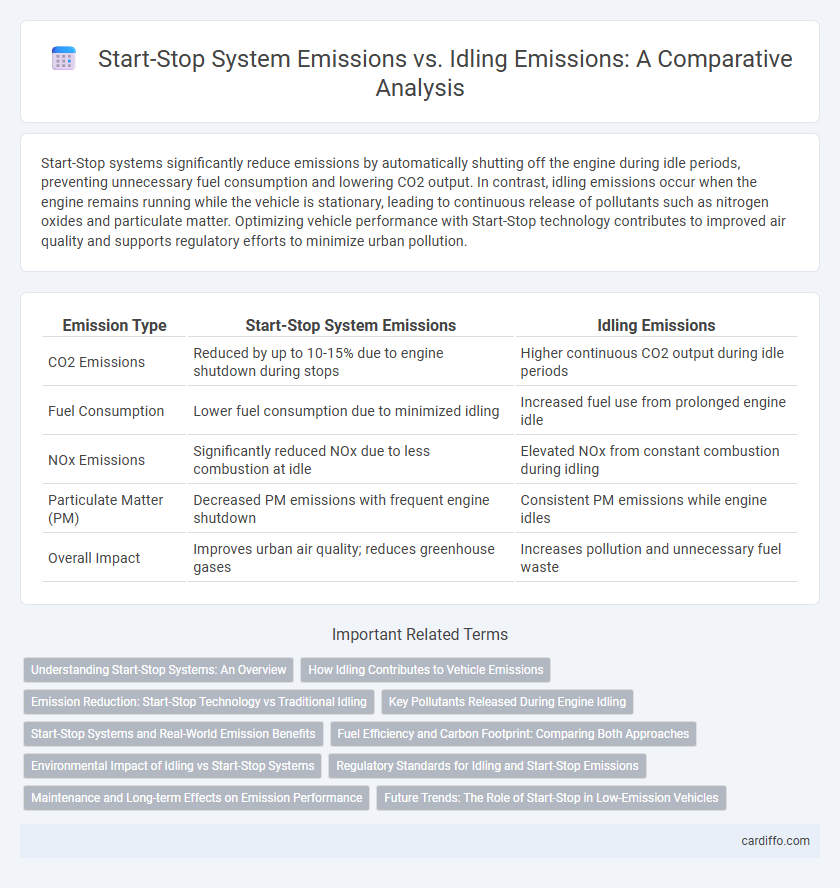Start-Stop systems significantly reduce emissions by automatically shutting off the engine during idle periods, preventing unnecessary fuel consumption and lowering CO2 output. In contrast, idling emissions occur when the engine remains running while the vehicle is stationary, leading to continuous release of pollutants such as nitrogen oxides and particulate matter. Optimizing vehicle performance with Start-Stop technology contributes to improved air quality and supports regulatory efforts to minimize urban pollution.
Table of Comparison
| Emission Type | Start-Stop System Emissions | Idling Emissions |
|---|---|---|
| CO2 Emissions | Reduced by up to 10-15% due to engine shutdown during stops | Higher continuous CO2 output during idle periods |
| Fuel Consumption | Lower fuel consumption due to minimized idling | Increased fuel use from prolonged engine idle |
| NOx Emissions | Significantly reduced NOx due to less combustion at idle | Elevated NOx from constant combustion during idling |
| Particulate Matter (PM) | Decreased PM emissions with frequent engine shutdown | Consistent PM emissions while engine idles |
| Overall Impact | Improves urban air quality; reduces greenhouse gases | Increases pollution and unnecessary fuel waste |
Understanding Start-Stop Systems: An Overview
Start-stop systems reduce vehicle emissions by automatically shutting off the engine during idle periods, such as traffic stops, minimizing fuel consumption and harmful exhaust gases. These systems significantly lower carbon dioxide (CO2) and nitrogen oxide (NOx) emissions compared to traditional idling, where the engine remains running. Understanding the technology behind start-stop systems highlights their role in enhancing urban air quality and improving overall fuel efficiency.
How Idling Contributes to Vehicle Emissions
Idling vehicles emit significant amounts of nitrogen oxides (NOx), carbon monoxide (CO), and particulate matter (PM), contributing heavily to urban air pollution. Unlike the Start-Stop System which reduces fuel consumption and exhaust emissions by shutting off the engine during stops, prolonged idling increases fuel use and pollutant output without aiding efficiency. Studies show that eliminating unnecessary idling can reduce vehicle emissions by up to 30%, highlighting the environmental importance of Start-Stop technology.
Emission Reduction: Start-Stop Technology vs Traditional Idling
Start-stop technology significantly reduces emissions by automatically shutting off the engine during idle periods, cutting CO2 and NOx emissions by up to 15-20% compared to traditional idling. Traditional idling keeps the engine running continuously, leading to higher fuel consumption and increased harmful pollutant output. Emission reduction through start-stop systems plays a critical role in improving urban air quality and meeting stringent regulatory standards.
Key Pollutants Released During Engine Idling
Engine idling emits significant quantities of key pollutants including carbon monoxide (CO), nitrogen oxides (NOx), and particulate matter (PM), which contribute to air pollution and respiratory problems. Start-stop systems reduce these emissions by shutting off the engine during idle periods, significantly lowering CO and NOx output compared to continuous idling. Studies show that vehicles equipped with start-stop technology can decrease idling emissions by up to 30-50%, improving urban air quality and reducing overall environmental impact.
Start-Stop Systems and Real-World Emission Benefits
Start-stop systems significantly reduce emissions by shutting down the engine during idle periods, cutting fuel consumption and lowering carbon dioxide output by up to 10-15% in urban driving conditions. Real-world studies demonstrate that start-stop technology decreases nitrogen oxide (NOx) and particulate matter (PM) emissions compared to traditional idling, improving air quality in congested areas. The integration of start-stop systems with advanced engine control optimizes emission reductions without compromising vehicle performance or driver comfort.
Fuel Efficiency and Carbon Footprint: Comparing Both Approaches
Start-stop systems significantly reduce fuel consumption and carbon emissions by shutting off the engine during idling, leading to lower tailpipe pollutants compared to traditional idling. Research indicates that start-stop technology can improve fuel efficiency by up to 10-15%, directly decreasing CO2 output and other harmful gases. In contrast, idling results in continuous fuel burn and higher emissions, contributing to increased carbon footprints and fuel wastage during traffic stops or waiting periods.
Environmental Impact of Idling vs Start-Stop Systems
Start-stop systems significantly reduce emissions by shutting off the engine during idle periods, cutting down on harmful pollutants like nitrogen oxides and particulate matter. Idling engines, in contrast, continuously release carbon dioxide and other greenhouse gases, contributing substantially to urban air pollution and climate change. Implementing start-stop technology leads to measurable decreases in fuel consumption and emission levels, promoting improved air quality and environmental sustainability.
Regulatory Standards for Idling and Start-Stop Emissions
Start-stop systems significantly reduce emissions by shutting off the engine during idle periods, aligning with stricter regulatory standards aimed at lowering urban air pollution levels. Regulations such as the European Union's Euro 6 and California Air Resources Board (CARB) mandates impose stringent limits on idling emissions, encouraging adoption of start-stop technology to meet targets for nitrogen oxides (NOx) and particulate matter (PM) emissions. Compliance with these standards drives innovation in engine control strategies to minimize pollutant output during both idling and engine restarts, contributing to improved air quality and reduced greenhouse gas emissions.
Maintenance and Long-term Effects on Emission Performance
Start-stop systems reduce emissions significantly compared to idling by shutting off the engine during inactivity, leading to lower fuel consumption and fewer pollutants. Regular maintenance of these systems ensures optimal sensor function and battery health, preventing increased emissions due to malfunction or inefficient restarts. Long-term, well-maintained start-stop systems contribute to sustained emission performance, whereas poorly maintained idling engines emit higher levels of CO2 and nitrogen oxides over time.
Future Trends: The Role of Start-Stop in Low-Emission Vehicles
Start-stop systems significantly reduce emissions by shutting off the engine during idle periods, cutting down on fuel consumption and harmful exhaust gases. Future trends indicate widespread adoption of start-stop technology in low-emission vehicles to comply with stricter regulatory standards and urban emission reduction targets. Integration with electric and hybrid powertrains enhances system efficiency, promoting cleaner, more sustainable urban mobility solutions.
Start-Stop System Emissions vs Idling Emissions Infographic

 cardiffo.com
cardiffo.com